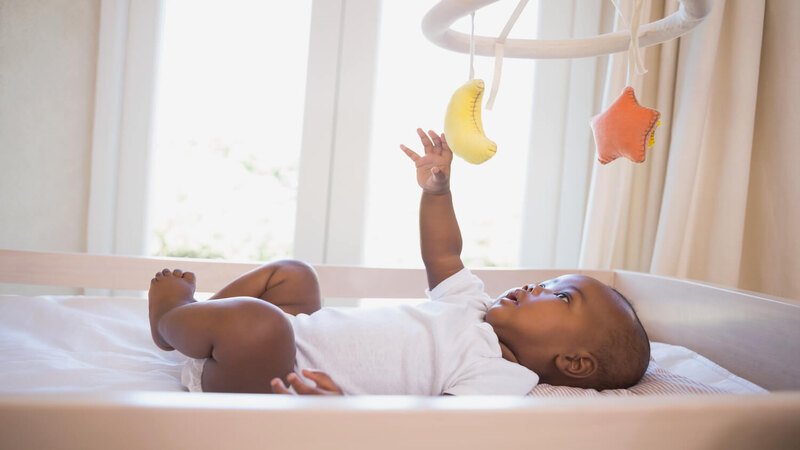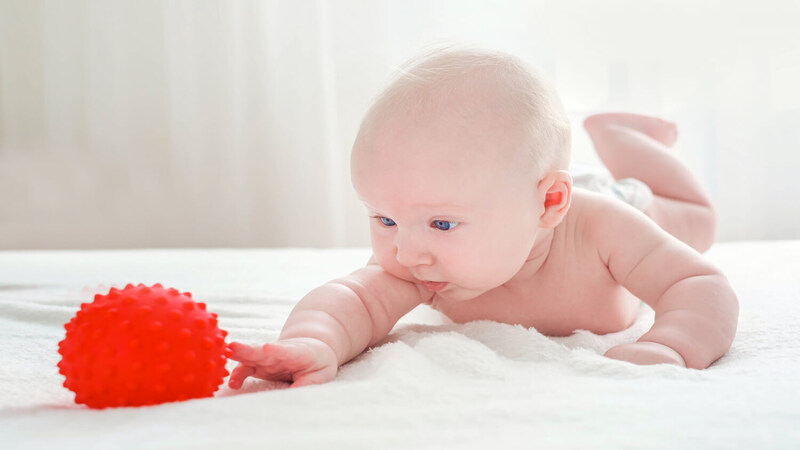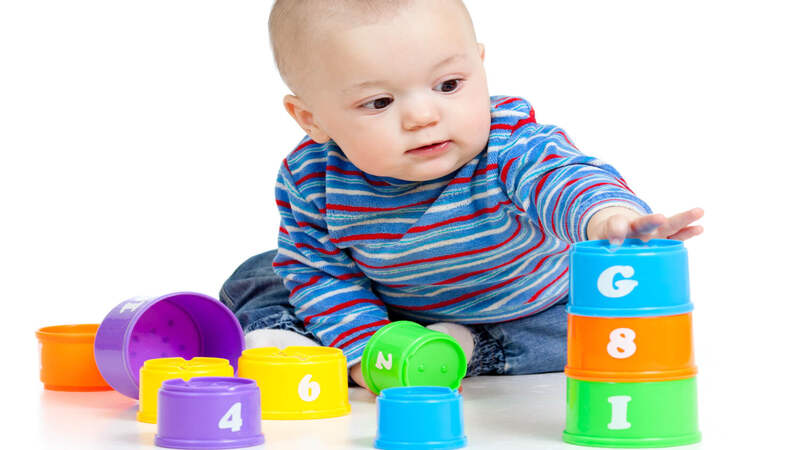
As soon as newborns can grip objects, they open up a whole new realm of play. However, like with everything, it will take some time and practice before kids are comfortable getting their hands dirty. So when do babies start reaching for objects? As with every milestone, different babies have different time frames and learning cures.
If your baby is developing slower than you expected, don’t worry; it’s normal for newborns to do so. For preterm babies, this is true even more so. Developing new physical abilities isn’t always simple for newborns, which may lead to tantrums and crying. If you’re having trouble, don’t be afraid to seek help from loved ones or your Health Visitor or Family Nurse.
When Do Babies Start Reaching For Objects?
A baby’s clutching and grasping abilities begin to emerge around the time of their fifth or sixth month of life. However, as your child progresses toward mastering this talent, you may anticipate steady growth in ability. Caroline Martinez, MD, associate professor of pediatrics and head of developmental pediatrics at Mount Sinai Medical Center, notes that individual newborns’ growth and development will naturally vary. This is a typical progression for most infants:
1. Reaching
When does a baby begin to grasp objects? When they’re around three months old, they’ll begin to observe things around them. The next step is for them to reach out and touch them.
2. Batting
When does a baby begin to swat at things? Michelle Macias, MD, a developmental pediatrician at the Medical University of South Carolina in Charleston, South Carolina, notes that babies may begin to bat or strike objects as early as three or four months of age, albeit their actions are not yet precise.
3. The Act of Bringing One’s Hands Midline
Babies will begin to move their hands into the center of their bodies, and, sure, they’ll put them right in front of their mouths before they’ve mastered the art of gripping.
4. Hands Outstretched
Things become pretty exciting once a baby’s hands begin to open more often, about 4 or 5 months of age! The capacity to grip items is much easier when the palm is open.
5. Grabbing
Strictly at what age do newborns begin to grasp? Babies may be able to grip and grab around the age of 5 to 6 months. Success!
6. Moving Things Around
Most newborns can move things from one hand to the other by the time they are six months old. By the time they’re nine months old, almost everyone will be able to do this feat.
7. Swaying and Thwacking
Babies may begin to shake rattles or bang their hands or other items on the ground to make noise between the ages of six and eight months.
During their exploration of hitting, grasping, and holding, kids may realize that particular motions influence their well-being (like a rattle making noise). The development of both the mind and the hands are intertwined.
How Babies Learn to Reach and Hold Things?

While newborns spend most of their days sleeping, you can expect your baby’s rapidly growing senses to unlock new abilities like reaching as she becomes more awake and attentive.
Two significant discoveries will be made by your baby just before they start reaching for things: Aside from the cot and playmat, there is a whole universe of toys, people, things, and other intriguing stuff. They can also reach out with their arms and hands to look at the items they find fascinating. Inspiring news!
Your baby’s tummy time is an excellent opportunity to encourage them to learn how to reach and grasp what she’s interested in. Praise them as they attempt to reach out for the items you’re holding. They may not have the hand-eye coordination at first to grasp everything they try to grab, but every piece of interactive play helps them develop that ability.
[Read : Tummy Time For Babies- A Must Do]
How Can You Help Your Baby With Reaching?

Using play to encourage development doesn’t have to wait till the baby is older. Start with a toy with a lot of contrast. Because newborns’ eyesight is still developing, black-and-white, brightly coloured, or fluorescent-and-black items might help draw their attention.
While keeping the toy within arm’s reach, slowly rock the toy back and forth and up and down before the baby. When they’re lying on their back, their hands are free to move. This activity may also be done in a stroller or car seat that supports the infant up.
High-contrast toys won’t cut it? Try a step higher. A baby’s senses will be stimulated by anything that has lights or produces noise. Better still if the toy is designed specifically for a baby’s tiny hands. A firm block is more difficult for little hands to grasp and move about than a ring or spherical rattle.
With toys in their hands, you can encourage a baby’s exploration of the world around them. At this stage, you should be able to position items of interest just out of reach of their graspable reach. Gross motor skill development may be facilitated by requiring them to use more muscles to accomplish their goals.
[Read : Baby’s Vision Development]
What Can You Do if Your Baby Isn’t Reaching?

Do you want to help your infant develop the ability to grasp objects? Here are a few entertaining methods to demonstrate to him how it’s done:
1. Show Off Their Knick-Knacks
Consider yourself a “toy curator,” demonstrating and discussing all the beautiful aspects of the playthings until your baby can reach and touch them. “It’s a cow, right there! Mooing is the sound of a cow.” This is a great game to play with your baby when lying on their stomach.
2. Encourage Them to go For it
Arrange a selection of toys like bright cups and soft balls just outside his arm’s reach and encourage him to stretch his hand for them during playing.
3. Boost The Visual Appeal With Some Dimension.
It’s a good idea to expose your child to various materials, from soft blankets to rubber blocks and noisy toys to baby-friendly board books.
4. Keep an Eye on Those Toes, Please!
Because babies like the feeling of exploring with both their fingers and their toes, include him in the pleasure. Set up an exercise gym with toys for your baby so that they may explore the possibilities of their hands and feet. Every new toy you offer to your baby teaches them more about object identification and cause and effect.
5. Snacking And Grasping go Hand in Hand.
Even before they can hold a pincer grip (around the age of 9 months), your baby will enjoy snatching food off of their highchair tray. Strips of ripe avocado, steamed broccoli, or quartered hard-boiled eggs might be served as a baby-led weaning diet.
So, when do babies start reaching for objects? You will, by now, have had a rough idea about the milestones and what you can expect in terms of different stages.
In case you find that your baby has issues, it is a good idea to see a pediatrician. After an examination, the infant will get an early intervention therapy plan tailored to their specific needs. We presume that the kid will catch up when we notice developmental deficits. Early intervention is critical because the brain has a lot of plasticities. You should notify your doctor if your child’s growth slows down. It’s time to take your kid to the doctor if they’ve lost a developmental milestone.
[Read: When Will My Baby Develop The Pincer Grasp?]
FAQ’s
1. Should My 3-Month-Old Baby Start Reaching Out For Things?
Yes, most 3 month old babies should start reaching out for things, be it a toy, a mother or a caregiver. You can attach your little one’s favorite toys to their cradle or crib so as to encourage them to reach out for their toys.
2. How Can I Encourage My Baby To Grab Things?
Place their favorite or colorful toys out of their reach and encourage them to grab these things. Reward their every small success with claps, smiles, and hugs. Tummy time is an excellent time to let your baby hone their grabbing and reaching out skills.
3. When Will My Baby Hold And Grab Things?
By their 6th month, most babies will start reaching for items, grab and hold them, and also transfer things from one hand to the other.
Read Also: When Do Babies Start Grabbing Objects?
